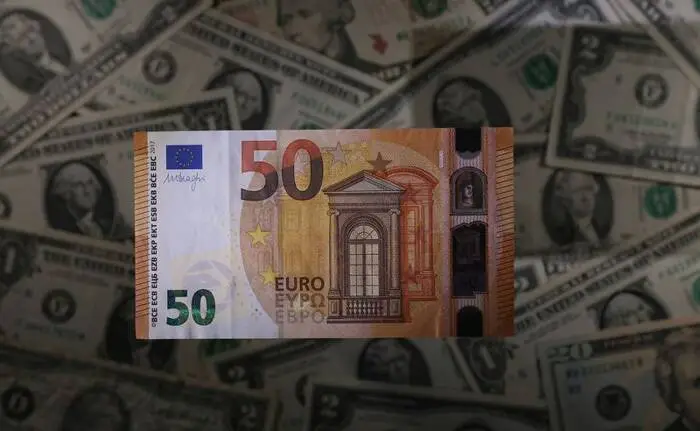简体中文
繁體中文
English
Pусский
日本語
ภาษาไทย
Tiếng Việt
Bahasa Indonesia
Español
हिन्दी
Filippiiniläinen
Français
Deutsch
Português
Türkçe
한국어
العربية
Currency markets calm, euro-dollar steady ahead of U.S. inflation data
Abstract:The Aussie and Kiwi dollars were trading near multi-week highs on Thursday as investors turned more bullish on risk assets such as equities while the dollar held in a narrow range ahead of U.S. inflation data due later in the day.

Currency market moves were small on Thursday as investors waited for key data on U.S. inflation to give clues on the Federal Reserves policy tightening trajectory.
Investors appetite for riskier assets has been hurt so far this year by expectations that the U.S. Federal Reserve will begin tightening monetary policy, starting with a rate hike at its March meeting.
Strong earnings helped global stocks rise on Wednesday, but they struggled to maintain this momentum during the Asian and early European sessions on Thursday.
Markets were focused on U.S. inflation data due later in the session. The headline consumer price index is expected to have increased more than 7% in January, year-on-year, a level reminiscent of the inflation shocks of the 1970s and 1980s.
“The higher the current inflation rates the stronger the perception is likely to be amongst market participants that the Fed will have to act even faster, more decisively and for a prolonged period of time than is currently expected,” wrote Commerzbank FX and EM analyst Antje Praefcke in a client note.
“That in turn is likely to provide a boost for the dollar.”
At 0825 GMT, the dollar index was down by less than 0.1% on the day, at 95.503. After large swings in the previous two weeks, it was on track for a minimal weekly change so far this week.
Investors are pricing in a 71% chance of the Fed hiking rates by 0.25 basis points at its March meeting, with as many as five rate hikes priced in for the year overall. [IR/PR].
Expectations that the European Central Bank would be slower to hike, as policymakers have been less concerned about inflation, generally kept euro-dollar subdued. But this changed last week when the ECB took a more hawkish stance at its meeting, prompting euro-dollar to jump to a three-week high of $1.1483.
At 0831 GMT, the euro was at $1.1428, little changed on the day. European government bond yields continued to edge higher, having surged last week following what analysts labelled as the ECBs “pivot”.
The Australian dollar, which is seen as a liquid proxy for risk appetite, was up 0.1% at $0.71875, while the New Zealand dollar was also a touch higher.
Also suggesting some appetite for risk, the Japanese yen hit a one-month low versus the dollar.
The Swedish crown was a touch lower against the dollar and euro after the Swedish central bank kept policy plans broadly unchanged, stressing that surging inflation is temporary and that it remains too early to begin withdrawing support from the economy even as the effects of the COVID pandemic fade.
In cryptocurrencies, bitcoin was around $44,260, in its third consecutive week of gains. But it remains far below the all-time high of $69,000 it hit last November.

Disclaimer:
The views in this article only represent the author's personal views, and do not constitute investment advice on this platform. This platform does not guarantee the accuracy, completeness and timeliness of the information in the article, and will not be liable for any loss caused by the use of or reliance on the information in the article.
Read more

Blockchain Decentralization: Empowering a Trustless Future
In recent years, blockchain technology has rapidly evolved from a niche innovation behind Bitcoin into a transformative force across industries. At its core, blockchain decentralization refers to the distribution of authority and decision-making away from a central entity and into the hands of a distributed network of participants. This shift redefines how data is stored and verified and paves the way for trustless, transparent, and resilient systems that challenge traditional centralized models.

The president of @Liberland, @Vít Jedlička come on stage, dialogue on trading security.
The 2025 WikiEXPO Hong Kong Station is about to grandly open. the president of @Liberland, @Vít Jedlička come on stage, dialogue on trading security.

Countdown: 1 day.WikiEXPO2025's first stop, Hong Kong, is about to open.
⏰ Countdown: 1 day. WikiEXPO2025's first stop, Hong Kong, is just tomorrow. Focus on transaction security and explore new investment opportunities. ???? Get ready to start now. See you tomorrow.

JustForex vs JustMarkets: A Comprehensive Comparison in 2025
Selecting the right forex broker can make the difference between trading success and frustration for most investors, especially retail investors. As retail traders gain unprecedented access to global markets, the choice between platforms like JustForex and JustMarkets becomes increasingly significant. Both brokers offer some shining features within the forex and CFD trading space, but their approaches differ in some areas.
WikiFX Broker
Latest News
The Withdrawal Trap: How Scam Brokers Lure Victims into Paying More
FCA to Investors: Think Twice Before Trusting These Brokers
Trump\s tariffs: How could they affect the UK and your money
Trump gambles it all on global tariffs he\s wanted for decades
TradingView Brings Live Market Charts to Telegram Users with New Mini App
Trump tariffs: How will India navigate a world on the brink of a trade war?
Interactive Brokers Launches Forecast Contracts in Canada for Market Predictions
Authorities Alert: MAS Impersonation Scam Hits Singapore
IG Group Acquires Freetrade for £160M to Expand UK Investment Market
U.S. March ISM Manufacturing PMI Released
Currency Calculator







